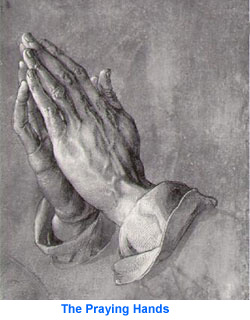 |
 |
 |
 |
| Volume
4 - Issue 02 FEBRUARY 2006 |
|
THE JOY OF GIVING Back in the fifteenth century, in a tiny village near Nuremberg, lived a family with eighteen children. Eighteen! In order merely to keep food on the table for this brood, the father and head of the household, a goldsmith by profession, worked almost eighteen hours a day at his Despite their seemingly hopeless condition, two of the elder children, Albrecht and Albert, had a dream. They both wanted to pursue their talent for art, but they knew full well that their father would never be financially able to send either of them to Nuremberg to study at the Academy. After many long discussions at night in their crowded bed, the two boys finally worked out a pact. They would toss a coin. The loser would go down into the nearby mines and, with his earnings, support his brother while he attended the academy. Then, when that brother who won the toss completed his studies, in four years, he would support the other brother at the academy, either with sales of his artwork or, if necessary, also by laboring in the mines. They tossed a coin on a Sunday morning after church. Albrecht Durer won the toss and went off to Nuremberg. Albert went down into the dangerous mines and, for the next four years, financed his brother, whose work at the academy was almost an immediate sensation. Albrecht's etchings, his woodcuts, and his oils were far better than those of most of his professors, and by the time he graduated, he was beginning to earn considerable fees for his commissioned works. When the young artist returned to his village, the Durer family held a festive dinner on their lawn to celebrate Albrecht's triumphant homecoming. After a long and memorable meal, punctuated with music and laughter, Albrecht rose from his honored position at the head of the table to drink a toast to his beloved brother for the years of sacrifice that had enabled Albrecht to fulfill his ambition. His closing words were,
All heads turned in eager expectation to the far end of the table where Albert sat, tears streaming down his pale face, shaking his Finally, Albert rose and wiped the tears from his cheeks. He glanced down the long table at the faces he loved, and then, holding his hands close to his right cheek, he said softly,
More than 450 years have passed. By now, Albrecht Durer's hundreds of masterful portraits, pen and silver-point sketches, watercolors, charcoals, woodcuts, and copper engravings hang in every great museum in the world, but the odds are great that you, like most people, are familiar with only one of Albrecht Durer's works. More than merely being familiar with it, you very well may have a reproduction hanging in your home or office. One day, to pay homage to Albert for all that he had sacrificed, Albrecht Durer painstakingly drew his brother's abused hands with palms together and thin fingers stretched skyward. He called his powerful drawing simply "Hands," but the entire world almost immediately opened their hearts to his great masterpiece and renamed his tribute of love "The Praying Hands." The next time you see a copy of that touching creation, take a second look. Let it be your reminder, if you still need one, that no one - no one - ever makes it alone! Source: Unknown - Heart2Heart Team |
| You can write to us at : h2h@radiosai.org |
Vol 4 Issue 02 - February 2006
|
Best viewed in Internet Explorer - 1024 x 768 resolution. |
DHTML Menu by Milonic. |
 trade and any other paying work that he could find in the neighbourhood.
trade and any other paying work that he could find in the neighbourhood.  lowered head from side to side while he sobbed and repeated, over and over, "No ...no ...no ...no."
lowered head from side to side while he sobbed and repeated, over and over, "No ...no ...no ...no."